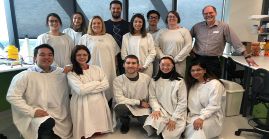
Being told that you have cancer is, for so many people, one of the hardest things they will ever have to hear. Fortunately for people diagnosed with cancer in Australia, they have more chance than most to survive – and things are only getting better.
A new study from the International Agency for Cancer Research has shown that people in Australia have the highest rates of survival in the world, topping a table also featuring Norway, Denmark, the United Kingdom, New Zealand, Ireland and Canada.
According to this research, people in Australia have the best chance of surviving at least one year after a cancer diagnosis. We also have the best five-year survival rates for cancers of the oesophagus, stomach, pancreas, rectum and colon, as well as the second-highest for lung and ovary cancers.
This is an incredible result, and Victoria has certainly played its part. Data from Cancer Council's Victorian Cancer Registry (VCR) joined figures from 20 other organisations.
Their data demonstrated just how much Cancer Council’s efforts in prevention and life-saving research – which generous supporters like you make possible – have done to ensure more people survive a cancer diagnosis.
These efforts have also seen the overall five-year survival rate increase from 46% in the 1980s to 69% today. Survival continues to climb, though for some cancers, such as lung and oesophageal, which were included in the recent study, survival rates are still unfortunately low.
Thanks to your support, Cancer Council Victoria researchers are helping to change this.
Working to improve quality of life and survival outcomes for oesophageal and lung cancer patients
Dr Nicholas Clemons and his team at the Peter MacCallum Cancer Centre are looking into how they can lift survivorship of oesophageal cancer from its current level of 23.5%, to help the 1,500 people in Australia diagnosed each year.
By developing more advanced testing for oesophageal cancer, Dr Clemons hopes to better tailor treatments to individual patients. This, he says, will improve not only the survivorship of patients, but their quality of life.

Dr Nicholas Clemons and his team are looking to lift the survival rates of oesophageal cancer
Dr Clemons said that while there have been significant improvements in outcomes for cancer patients in the last few decades, his research is one part of the significant amount of work left to do to see fewer lives lost to cancer in Australia.
“There are some cancers, such as oesophageal cancer, where outcomes for patients haven’t really improved that much,” he said.
“It’s the desire to make advances in how we treat and manage patients with these low outcome cancers that challenges and motivates me to undertake my research. There is still so much to do.”
This crucial work, which is funded for the next three years, wouldn’t be possible without the support of people like you. And it’s certainly not the only piece of research looking into low-survival cancers, such as lung cancer – another which was included in the International Agency for Cancer Research study.

Dr Catherine Granger, a researcher at the University of Melbourne, is looking for a better way to care for lung cancer patients after treatment, to help more people in Australia survive a diagnosis.
Recovering from lung cancer treatment is a difficult process, with patients often experiencing illness, fatigue and a much lower quality of life for several years afterwards, Dr Granger says. By studying the effects of exercise on the recovery of lung cancer patients, Dr Granger is hoping to help people through this journey.
“It’s vital we … improve patient outcomes,” Dr Granger said. “That is the goal of our project.”
With lung cancer having a survival rate of just 21.4%, Dr Granger hopes to improve this figure by drawing on her history as a physiotherapist.
Her study will enrol patients prior to their surgery before randomly assigning them to either usual care or an exercise program afterwards. Exercise, Dr Granger says, is often not part of clinical practice, despite potentially high benefits for patients of this low-survival cancer.
“Lung cancer is a major challenge to healthcare,” Dr Granger said. “Following surgery, patients have needs which are not currently addressed in clinical practice.
“Targeted exercise training is not part of usual care for patients with lung cancer. This is partly due to lack of strong evidence for the benefits of exercise, as well as the lack of clinically feasible programs.
“Our project addresses this gap. It will be the first project of its kind in lung cancer worldwide.”
Researchers like Dr Granger, Dr Clemons, and so many others, are all working to help bring about a future in which fewer lives are lost to cancer. Thanks to generous people like you, this goal is possible.
Continued support for life-saving cancer research, as well as prevention and support services, can not only help maintain Australia’s world-leading rates of survival. It also brings us closer to a cancer free future, and that is an incredible goal to be working towards.
International Agency for Cancer Research facts
What countries? Australia, New Zealand, Ireland, United Kingdom, Norway, Denmark and Canada.
What cancers? Oesophagus, stomach, colon, lung, rectum, pancreas and ovary.
How many cases? 3.9 million anonymous cases.
When? The data were from diagnoses between 1995-2014, followed up until 31 December 2015.
How did Australia do? Australia had the highest five-year survival rates for cancers of the oesophagus (24%), stomach (3%), colon (71%), pancreas (15%), and rectum (71%), and the second-highest for lung (21%, behind Canada), and ovary (43%, behind Norway).